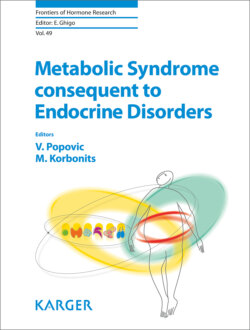Читать книгу Metabolic Syndrome Consequent to Endocrine Disorders - Группа авторов - Страница 34
Other Cardiometabolic Risk Factors in Acromegaly
ОглавлениеActive acromegaly presents a unique combination of features associated with an increased cardiovascular risk. Despite having a striking reduction in insulin sensitivity, patients with acromegaly have lower total and trunk fat mass and higher lean body mass. Both, the traditional and the emergent biomarkers of cardiovascular risk behave somewhat differently in active acromegalic patients as compared to the general population.
Dysfunctional adipose tissue is recognized as a substantial contributor to insulin resistance by endocrine cross-talk among tissues involved in glucose metabolism [44]. Several adipocyte-derived mediators play a central role in the regulation of insulin sensitivity and in the promotion of the chronic inflammatory state that characterizes atherosclerosis [45]. These mediators are known as adipocytokines, and while some of them are pro-inflammatory (leptin, resistin, interleukin [IL]-1beta, IL-6, IL-8, IL-17, tumor necrosis factor-alpha, monocyte chemoattractant protein-1), others have anti-inflammatory properties (adiponectin, omentin, IL-10) [45]. In vitro, GH but not IGF-1 increases the expression of vascular endothelial growth factor and monocyte chemoattractant protein-1 in cultured mature adipocytes, but appears to have no effect on the genetic expression of resistin, tumor necrosis factor-alpha, IL-6, IL-8, IL-1beta [46]. Adiponectin gene expression appears to be regulated by IGF-1 but not by GH [47].
Adiponectin is an adipocytokine with anti-atherogenic and anti-inflammatory properties that has a direct effect on endothelial cells and on the transformation of macrophages into foam cells [48]. In healthy individuals, adiponectin levels are inversely correlated with BMI and body fat mass [49]. In patients with acromegaly, this inverse correlation is lost perhaps due to the fact that these patients have a lower adipose tissue mass than BMI-matched control individuals [50]. Circulating adiponectin levels in patients with acromegaly are no different from controls [46, 50]. However, obese acromegalic patients have significantly higher adiponectin levels than obese controls [50]. More importantly, acromegalic patients with a lesser degree of adiposity and insulin resistance, as estimated by the visceral adiposity index have significantly higher adiponectin levels than those with a high visceral adiposity index [51]. Control of acromegaly with surgery but not with medical treatment with SSA or pegvisomant tends to increase adiponectin levels [46].
Leptin is another adipocytokine synthesized and secreted by adipose tissue that is crucial in appetite regulation and energy expenditure and its circulating levels positively correlate with body fat mass and waist circumference [52]. Leptin levels in patients with acromegaly are significantly lower than in healthy controls and do not correlate with BMI or waist circumference [50, 53]. Surgical treatment of acromegaly has been shown to result in an increment of leptin levels in some [53] but not all studies [46]. Treatment with SSA but not with pegvisomant also increases leptin levels in patients with acromegaly [46].
